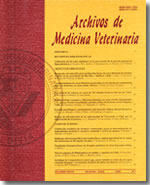Genetic factors involved in resistance to infectious diseases in salmonids and their application in breeding programmes
Main Article Content
Abstract
The control of infectious diseases is essential in the success of salmon aquaculture. Genetic improvement of disease resistance may provide a feasible and sustainable option for the management of these diseases. Marker-assisted selection (MAS) or Gene-assisted selection (GAS), represent a valuable alternative to the conventional schemes for improving disease resistance using pedigree. Nevertheless a previous knowledge of the genetic factors involved in the trait is necessary to implement this methodology. In this review, the most important aspects of genetic resistance to infectious diseases in salmonids and their suitability for breeding programmes are both reviewed and discussed. Firstly, we briefly mention the most important infectious diseases in Chile. Furthermore, we include aspects related with conventional breeding for this quantitative trait, such as selection criteria, genetic variation of resistance and genetic correlations with other traits. We also review three approaches used in molecular identification of genetic factors involved in resistance: candidate genes, with particular emphasis on the major histocompatibility complex (MHC) or MH genes, detection of quantitative trait loci (QTL) and gene expression studies. Finally, we discuss the use of this information in the implementation of breeding schemes that include disease resistance in their breeding goal.

